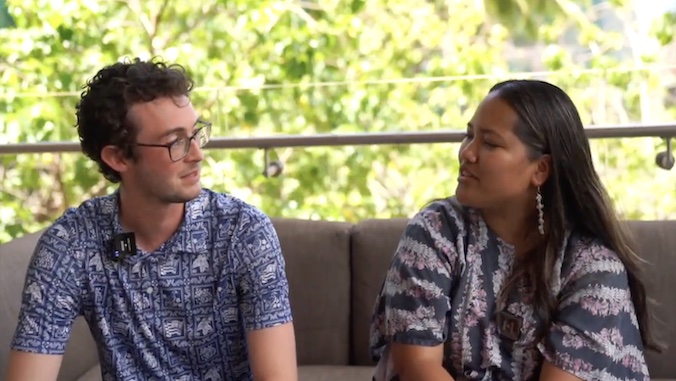
Third year medical school students Ashley Lee and Joshua Kepler of the University of Hawaiʻi at Mānoa John A. Burns School of Medicine (JABSOM) were on Maui for their longitudinal clerkships when the August 8 wildfires occurred. Overnight, they immediately pivoted from learning to doing, providing hands-on care for hundreds who survived the deadliest U.S. wildfire in more than a century.
In the two weeks after the fire, each student interacted with upwards of 20 people daily.
More on how to help Maui ʻohana and the Maui wildfires.
“A lot of people had burns on their arms, their feet, a lot of people fled on foot from Lahaina,” Kepler said.
“We started going to the shelters with our preceptors, and then I think that’s when we really saw the extent of it firsthand,” Lee said. “We saw all the wounds, the burns and the mental health extent of it, too.”
Family ties on the Valley Isle
Lee and Kepler chose to do part of their clerkships on Maui due to their ties with family on the Valley Isle. Lee’s maternal relatives resided there, and Kepler grew up on Maui, where his grandfather and father also practice medicine.
We started going to the shelters with our preceptors, and then I think that’s when we really saw the extent of it firsthand.
—Ashley Lee
With Lee at the JABSOM house in Makawao and Kepler with family in Kīhei, the students were on Maui for two months before the wildfire, soaking in the knowledge passed down by the doctors who taught them each day.
“We did hands-on clinical care,” Lee said. “We would see patients, present them to our faculty supervisor or preceptor, and devise a plan together. This allows us to apply what we learned in the first two years and learn more by doing.”
Like others on Maui, the wildfires caught the JABSOM students off guard.
“I went home Tuesday night, and around midnight, our family got an emergency call notification to evacuate our house,” Kepler said. “We didn’t think the fires were that close at the time, but in an abundance of caution, we left. We could return that next morning, and that’s when the news broke to pretty much everyone. At the time, we had no idea the extent of what had happened in Lahaina. There was no electricity or cell, so I was just as in the dark as everyone else.”
Connecting with survivors
Connecting with survivors became the new mission for the JABSOM students. They went to shelters at Maui High School and War Memorial Stadium, but they say the people there were just a fraction of the true number of people needing care.

Lee partnered with Mauna Medic Healers Hui, a grassroots Native Hawaiian medical care organization, and went into Lahaina. She and Kepler practiced the skills they honed for the last two months and served the community in ways they never had before.
“A lot of them were just scared to leave where they were,” Lee said. “They didn’t know if the roads would be closed or if they could come back in if they went out to get resources or donations. They didn’t even want to go out a few minutes to the gateway center where they were distributing donations because they would have to drive past like the fire, which was very traumatic for them. So we did a lot of house calls. We went to hotel rooms and talked to anybody staying at the beach parks.”
At the clinics, Kepler treated survivors facing other immediate health issues.
“Some of them no longer have homes, but they still have their doctor’s visits. Some of them still have homes but no loved ones,” he said. “I’ve been focusing on the chronic disease management side and helping my preceptors ensure that we are still there to care for hypertension and diabetes. We want to make sure that that doesn’t get out of control while the rest of life is just in disarray.”
The experience gave the students an up-close look at the disaster’s devastating effects on people’s physical and mental health. JABSOM students are taught to care for a patient as a whole, and because psychiatry is part of their rotations, Lee and Kepler were equipped to fill that need.
Bringing aloha, unity to Maui
“I think the biggest theme right now is how we can bring aloha to this situation. We should focus more on bringing aloha to the situation, bringing everybody together, being unified and helping one another,” said Lee.
“I’m grateful that the majority of the Maui community has been able to come together so quickly,” Kepler said. “We haven’t, at least in my lifetime, had a disaster like this on Maui. Immediately, everyone was doing everything they could to help out. Donating goods, volunteering at the shelter, flying helicopters and driving up their boats. The entire island is coming together as one to provide aid in any way we can.”
Read more on the JABSOM website.

